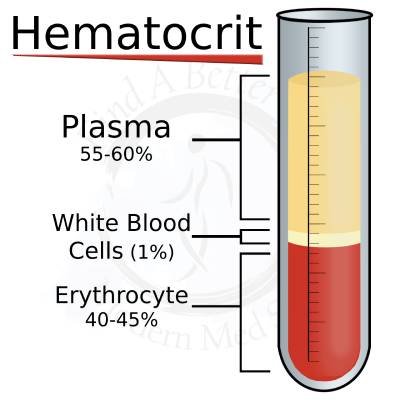How Elevated Hematocrit Affects Testosterone
Testosterone therapy is becoming more and more popular for men with testosterone deficiency, or “low T.” It can bring amazing benefits like more energy, better mood, more muscle, and better sex. But like any medical treatment, testosterone therapy isn’t without its side effects. One of the concerns that comes up is the risk of elevated hematocrit.
Understanding Hematocrit and Red Blood Cells
Hematocrit measures the proportion of red blood cells in your blood. These red blood cells are crucial as they carry oxygen from your lungs to the rest of your body, ensuring that your tissues and organs function properly. Various factors can influence hematocrit levels, including hormone therapy, dehydration, smoking, and even living at high altitudes. Keeping an eye on your hematocrit levels is essential, especially if you’re undergoing any form of hormone therapy.
Hematocrit is the percentage of red blood cells in the blood. Red blood cells carry oxygen throughout the body. When hematocrit gets too high, it can cause problems, so it needs to be monitored regularly during testosterone therapy. This can be done with a simple blood test.
Normal Hematocrit Levels?
For men, the normal hematocrit range is 41%-50%, and for women 36%-44%.
Why Does Hematocrit Matter?
When hematocrit gets above normal range your blood gets thicker and doesn’t flow as smoothly. Your heart has to work harder which can lead to serious problems like blood clots, strokes, or even heart attacks. Like using the wrong type of laser in hair removal treatments, not monitoring hematocrit during testosterone therapy can lead to big problems down the line. Check with your doctor regularly.
How Testosterone Therapy Increases Hematocrit
Testosterone increases red blood cell production, which is one reason it can increase hematocrit. Testosterone stimulates the production of erythropoietin (EPO), a hormone that tells the bone marrow to make more red blood cells. While this increase can improve oxygen transport, too much of a good thing can be bad—especially for older patients or those with pre-existing heart conditions. Just like choosing the right type of laser treatment, you need to have the right balance with your testosterone levels.
Effects of Elevated Hematocrit on Testosterone
Elevated hematocrit levels can profoundly impact testosterone levels. When hematocrit levels rise too high, the body may reduce testosterone production to compensate for the increased red blood cell count. This can lead to symptoms such as fatigue, weakness, and decreased libido. Monitoring hematocrit levels closely during testosterone therapy is essential to prevent these adverse effects and ensure that both hematocrit and testosterone levels remain within a healthy range.

By understanding the intricate relationship between testosterone and hematocrit, you can better manage your health and make informed decisions about testosterone therapy. Always consult with your healthcare provider to tailor your treatment plan to your specific needs and monitor your hematocrit levels regularly to enjoy the benefits of testosterone therapy safely.
By understanding the intricate relationship between testosterone and hematocrit, you can better manage your health and make informed decisions about testosterone therapy. Always consult with your healthcare provider to tailor your treatment plan to your specific needs and monitor your hematocrit levels regularly to enjoy the benefits of testosterone therapy safely.
Health Risks of High Hematocrit
When hematocrit gets too high during testosterone therapy you can experience the following:
- Increased blood viscosity: Thick blood is harder for the heart to pump, which increases the risk of cardiovascular problems.
- Polycythemia: Excess red blood cells, headaches, dizziness, fatigue.
- Blood clots: High hematocrit increases the risk of clots which can lead to heart attack, stroke, or pulmonary embolism.
- Partial arterial occlusion: High hematocrit can block arteries, reduce oxygen flow to organs, and increase the risk of organ damage.
Just like using the wrong laser in hair removal can cause burns or skin damage, not managing high hematocrit can lead to big problems if left unmanaged.
Monitoring Hematocrit During Testosterone Therapy
Your healthcare provider should monitor your hematocrit before starting testosterone therapy, especially if you have testosterone deficiency syndrome, and do follow-up tests – every 3, 6, or 12 months. If hematocrit gets above 54% for men or 48% for women it’s time to make adjustments. Just like switching from IPL to a medical-grade laser for better results, adjusting your testosterone dosage or frequency may be the key to lowering hematocrit safely.
How to Manage Elevated Hematocrit
If you have elevated hematocrit, here’s what you can do:
- Adjust testosterone dosage or frequency: This is usually the first step to get levels back in range.
- Switching methods: Just like choosing the right laser for hair removal, switching from injections to gels or pellets may reduce testosterone spikes and lower hematocrit.
- Lifestyle changes: Staying hydrated, exercising regularly, and making dietary changes can also help manage high hematocrit.
- Temporary pause in therapy: Taking a short break in treatment can allow hematocrit to stabilize before resuming.
- Medications or blood donation: Some doctors may recommend blood donation or specific medicines like aspirin to reduce blood viscosity and lower hematocrit.
Testosterone Therapy isn’t for Everyone
For some patients, testosterone therapy can increase hematocrit too high despite managing it. In these cases, you may need to look into alternative treatments for low testosterone such as SARMs or other hormone therapies. Just like switching from IPL to medical grade laser for laser hair removal, sometimes you need to find the right tool to get the best results without the side effects.
Bottom line: Testosterone Replacement Therapy
Testosterone replacement therapy has many benefits, but you need to work with a knowledgeable healthcare provider to monitor and manage your elevated hematocrit, just like you would want to choose a certified tech for laser hair removal. Stay on top of your hematocrit and make adjustments as needed, and you can safely enjoy the benefits of testosterone therapy with minimal risk. Always consult with your doctor to get on the right track.

Meet the Doctor
Dr. James Sturm D.O. DABA, FIPP
Dr. James Sturm is board-certified in Aesthetics in St. Peters, MO, and sees patients from all over the world. He is committed to helping you become the best version of yourself. Dr. Sturm has over 30 years of experience and prefers non-invasive techniques that benefit his patients the most.
